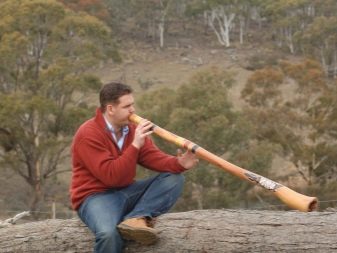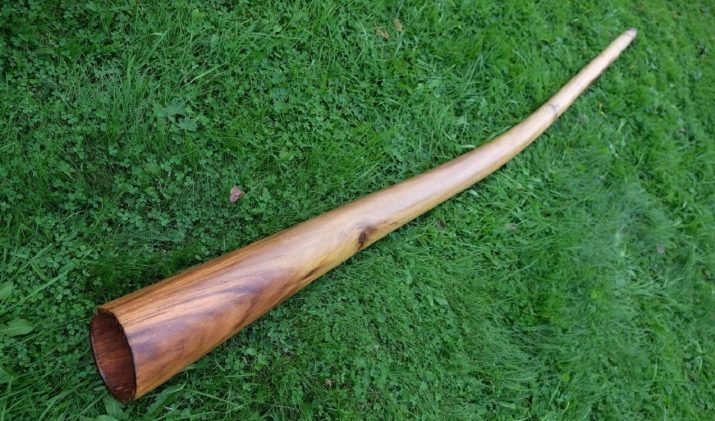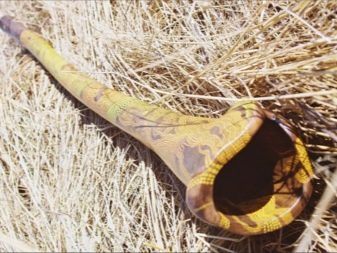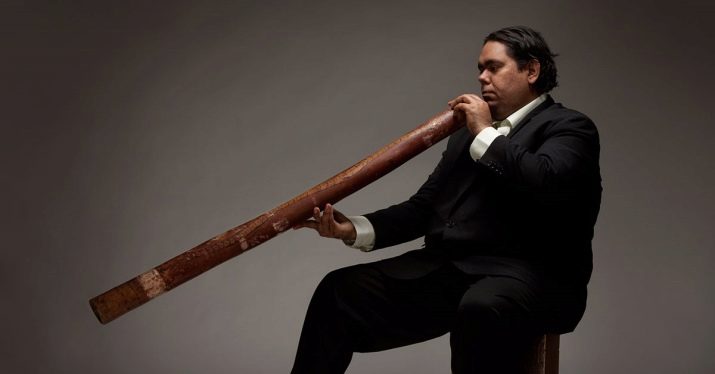All about didgeridoo

The didgeridoo is called the musical voice of a continent like Australia. This is a rather ancient musical instrument, but it has become widespread in modern music not so long ago, and therefore many are not familiar with it. The article will talk about what a musical instrument with such an interesting name is, about the history, varieties of didgeridoo, sound and features of the game.


What it is?
Currently, the didgeridoo is not widely known. However, it is he who is considered to be one of the oldest wind musical instruments in the whole world. At the same time, the Australian aborigines often use it in various shamanistic ceremonies and rituals, where the didgeridoo is one of the most important components.
To imagine what such an interesting Australian musical instrument looks like, it is enough to recall a well-known and familiar tune for all. However, the didgeridoo has a number of features that distinguish this instrument from the same pipe.
However, we will talk about them a little later, and first let's turn to the history of the origin of this musical instrument.

History
As mentioned, the didgeridoo is originally from Australia. It is the main part of the mythology of the aborigines living in some areas and symbolizes the image of the rainbow snake Yurlungur. Such a mythological character is the patron saint of nature, or rather, the sky, rain and water.
Usually, playing this musical instrument promotes immersion in a trance and is performed most often during the corrobori rituals, which is a special ceremonial dance performed by men. With the help of this kind of rituals, according to the aborigines, communication with the gods takes place.In addition, it also happens that by playing the didgeridoo, an aborigine is trying to lure a girl or woman whom he really liked.


The name of the described musical instrument "didgeridoo" began only in the West. The indigenous people inhabiting mainland Australia call this musical instrument differently, and there is simply no one specific name. So, among the peoples living in some regions, it is "Yolngu", "Bombo", "Pampu", "Martba" or "Jinan", among the representatives of other regions - "Kakutyu", "Yiraki", "Meialai" or "Yedaki" ...
There are actually a lot of names, all those listed above are only a minor part of all existing ones.

However, such an Australian wind instrument as the didgeridoo is held in high esteem not only among the Australian aborigines. At the beginning of the 20th century, the famous composer Steve Roach, who at that time was traveling in Australia, became interested in him. He was attracted by the sound of this musical instrument, which was rather unusual and peculiar. Roach learned to play such an interesting musical instrument from the aborigines, and soon the western part of the world was flooded with ethnic music new to her. So the didgeridoo became an integral part of club compositions, absolutely everyone lit up to it on the dance floors.
The name of Richard David Jones, a famous Irish musician, is also associated with this musical instrument. He, using didgeridoo, created the song Didgerido, which literally blew up British clubs in the early 90s of the last century. So the tool got even more widespread.

Despite its archaic nature, didgeridoo is only gaining its popularity. At the moment, its sound can be heard not only among the aboriginal tribes, but also at various national festivals. Today he is also involved in various musical contemporary melodies of various styles, including rock and jazz, blues and rap, reggae and ambient, and many others.
Drew attention to this musical instrument and performers of the legendary group The Beatles. So, during one of their tours in Australia, they tried to use the didgeridoo in the performance. They were quite impressed by this experience.

At the present time, festivals of such performers who play an unusual musical instrument are steadily held. The most ambitious of them is considered the festival, which bears the name Airvault; it has been held in France for more than a decade. It should be noted that this kind of festival took place in Russia as well. This event dates back to June 28, 2008. The festival of such an instrument as the didgeridoo was held in the northern capital of our country, St. Petersburg. By the way, in our country there is even a so-called didgeridoo day, it is marked on the calendar with the same date, June 28.
It will also be interesting that the didgeridoo is now actively used not only in the music field, but also in the field of medicine. With the help of it, people get rid of snoring. In addition, it helps relieve stress, relieve cramps and various pains, and also helps to relax muscles and launch special internal self-healing processes.
The sound of the didgeridoo is also a great addition for all those who are into meditation.


What is a tool?
A musical instrument like a didgeridoo can look completely different, at least among its, so to speak, discoverers - the aborigines. Nature itself is engaged in its creation, it is not made by hands. Usually aborigines do this: they find a trunk of eucalyptus or bamboo, the core of which has been completely eaten away by termites, after which they take this hollow tree, remove all excess, and make the mouthpiece from wax. This was the end of the manufacturing process for such an environmentally friendly musical instrument.
Therefore, we can say for sure that somewhere it will be quite difficult, if not impossible, to find two such identical wind musical instruments, because each tree is unique and has its own characteristics, and therefore each didgeridoo instrument will differ not only in visual qualities, but also in the timbre of its sound.




The didgeridoo usually looks like a pipe or pipe, which may well reach a size of one to 3 meters. The weight of such an unusual instrument can reach from one and a half to two and a half kilograms.
In the modern world, after the discovery of a musical instrument by Steve Roach, didgeridoo began to be made not only from a bamboo trunk, but also from cheaper materials, for example, from plastic or vinyl.

Today, didgeridoo has a sufficient number of varieties. Each of them has its own characteristics.
So, a kind of didgeridoo like Keyed, differs from the others in its equipment with a valve system.
Multidrone has a different shape and structure of the channel.


This kind of musical instrument, the didgeribone, is, so to speak, the child of such musical wind instruments as the trombone and didgeridoo. The length of this type of instrument is variable, since its structure implies the presence of two tubes inserted into one another.
A variety of didgeridoo like Flute has special holes for sound.
This feature makes it possible to perform the most complex musical compositions on the instrument.

Sound features
The sound of the didgeridoo is quite distinctive and unique. It is difficult to compare it with anything else, and it is all the more impossible to confuse it with something. Its sound evokes many associations with something mystical and mysterious, it fascinates people and, indeed, is able to put them into a trance.
It is impossible to deny the connection of the aborigines with the environment, nature. The howling of the wind, the singing of birds, the voices of animals - they try to convey all these sounds with the greatest accuracy by playing the didgeridoo. Thanks to the sound of the didgeridoo in combination with the throat intonations of the player, it is possible to do this.


This instrument has a fairly wide range of timbre, which can be compared with a human voice or the sound of a jew's harp. A feature of a musical instrument is that it sounds only on one note. Its pitch directly depends on parameters such as length and width. So, if the didgeridoo is not long, but wide, then its sound will be the highest. A longer, but narrower instrument will sound several times lower.
How to play?
Learning to play the didgeridoo is quite a challenge. In addition to having a sense of rhythm, you also need to possess the technique of continuous permanent breathing, which is quite difficult. It will be much easier for all those people who have previously played a particular wind instrument. In general, playing the didgeridoo is somewhat similar to playing the trumpet.

Sound production
When playing the didgeridoo, the facial muscles, the muscles of the neck and tongue, and the diaphragm are especially involved. The main movements during sound production are usually performed by the tongue and cheeks, while the lips remain motionless, their job is to make the didgeridoo hum evenly and without interruption, thereby causing special vibrations.

Continuous breathing
This type of breathing is also called circular breathing. It is this that makes it possible to play without stopping, even at the moment when you need to take a breath.
Its essence is as follows. Before exhaling, a person puffs out his cheeks, they contract, thereby releasing the rest of the oxygen, while the lips do not stop vibrating. Along with this, a sharp breath is made through the nose.
This breathing is not easy to learn, and it takes professional musicians many days of hard training.


Game techniques
The didgeridoo game is difficult to rank among the standard ones.The sound during the game, as already mentioned, is produced thanks to lip vibrations.
There are the following styles of play: with the front of the mouth or with the lips. It is worth choosing the technique that seems most convenient.

For information on how to make a didgeridoo with your own hands, see the next video.








